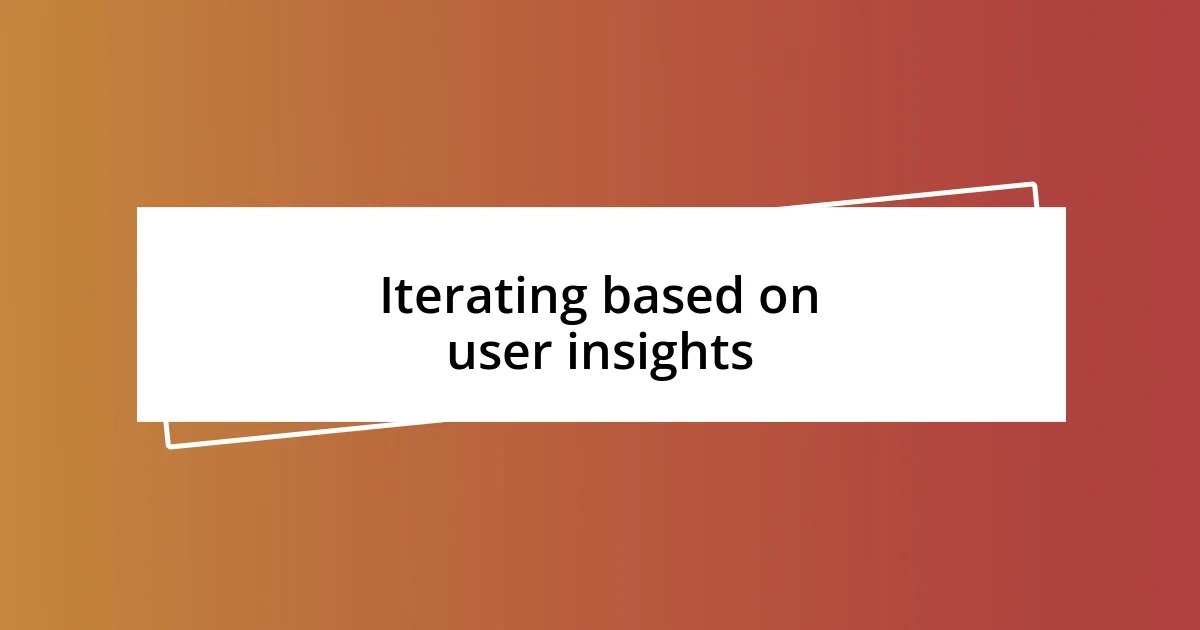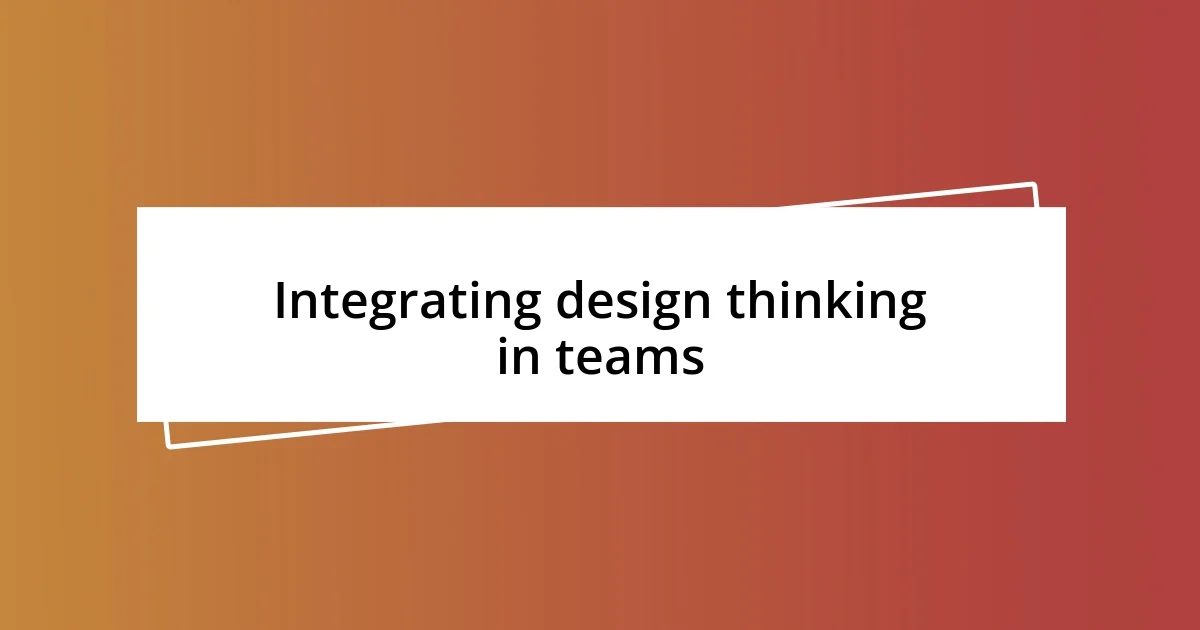Key takeaways:
- Empathy is crucial in design thinking; observing users reveals insights that significantly improve user experience.
- Iterative design, driven by user feedback, enhances product relevance and effectiveness through continuous refinement.
- Collaboration within diverse teams fosters creativity and innovation, leading to more user-centered solutions.

Understanding design thinking process
Design thinking is all about empathy and understanding the user’s needs. I remember a web project where we spent a day simply observing users interacting with our prototype. The insights we gathered transformed our approach—realizing that we had overlooked key frustrations in the user experience led to significant changes that ultimately delighted our users.
At its core, the design thinking process consists of five phases: empathize, define, ideate, prototype, and test. Each phase feeds into the next, but I often find that the real magic happens in the empathy stage. Ask yourself: How often do we pause and truly listen to our users, rather than assuming we know what they want? This humility and willingness to learn can unlock solutions we never considered.
During a recent project, we iterated our designs based on user testing feedback, which was surprisingly emotional for the team. Seeing users visually connect with our work reinforced my belief in the importance of the iterative process. It reminded me that design isn’t just about aesthetics; it’s about creating meaningful connections that resonate on a personal level.

Identifying user needs effectively
To effectively identify user needs, I find it crucial to step into their shoes through direct interaction. Last year, during a project for a nonprofit organization, we conducted in-depth interviews with potential users. The candid stories they shared illuminated their struggles, revealing intricate details about their expectations and pain points. This deep connection made it clear that the needs they articulated often came with underlying emotions that traditional surveys failed to capture.
When I analyze user feedback, I focus not only on what they say but also on how they feel. Here are some strategies that have proven effective:
- Conduct Interviews: Engage users in one-on-one conversations to dive deeper into their thoughts and feelings.
- Utilize Surveys: Implement structured surveys to gather broad insights, but ensure they allow for open-ended responses.
- Create User Personas: Build detailed profiles that represent different segments of your user base, helping to visualize their needs and motivations.
- Map User Journeys: Visualize the entire experience from the user’s perspective to identify key touchpoints and pain areas.
- Analyze Feedback: Look for patterns in user comments and behaviors—these often reveal unspoken needs.
Focusing on these aspects not only enhances the clarity of user needs but also fosters a stronger bond between the project team and the users we aim to serve. It’s a journey of discovery that can lead to innovations and solutions that genuinely resonate.

Implementing ideation in web design
Implementing ideation in web design is a pivotal step that transforms raw ideas into actionable concepts. I vividly recall a brainstorming session where we utilized sticky notes to map out different features for an interface. The energy in the room was palpable as ideas flowed freely, each one building on the last. It was fascinating to see how a simple concept sparked a chain reaction, leading to a cascade of innovative solutions we could never have devised alone.
Collaboration is at the heart of effective ideation. My team and I often engage in design sprints that harness collective creativity. By inviting diverse perspectives, we can challenge assumptions and explore possibilities. I recently participated in a multi-disciplinary workshop where designers, developers, and even marketers shared their viewpoints. This collaboration led us to rethink our navigation structure, ultimately creating a more intuitive user experience. Have you ever noticed how a fresh perspective can completely reshape your thinking?
During the ideation phase, I also champion the use of sketching and prototyping. These tangible representations breathe life into abstract ideas, allowing us to visualize potential solutions. If I share a sketch with a colleague, their response often sparks further refinement—it’s a powerful way to iterate without the weight of perfectionism. I believe that the ideation process can be a joyful exploration, where the journey itself reveals insights that guide our design decisions.
| Approach | Benefits |
|---|---|
| Brainstorming Sessions | Encourage free-flowing ideas and foster creativity. |
| Collaboration Workshops | Bring diverse perspectives and insights, enhancing problem-solving. |
| Sketching and Prototyping | Visualize concepts quickly and facilitate feedback, promoting iteration. |

Prototyping solutions with design thinking
Prototyping is where the magic of design thinking truly comes to life. I remember a time when my team worked on a web application for a local startup, and we decided to create a low-fidelity prototype using paper sketches. Something about physically crafting the design with my hands brought a rush of excitement. As we presented these sketches to real users, their immediate feedback helped shape our thought process; it was as if they were co-designers in the journey. Have you ever witnessed how quickly an idea can evolve with just a few user insights? It’s exhilarating!
When I think about prototyping, I also consider the importance of digital tools that facilitate this process. For instance, using a platform like Figma has changed how I approach design iterations. The ease of making quick changes and instantly sharing those updates with stakeholders has drastically shortened our feedback loop. One particular project I worked on for an e-commerce site saw us rapidly iterate on the checkout flow. With each version tested, the user experience improved tremendously, turning a clunky process into a seamless one. It was inspiring to see firsthand how an effective prototype can spark a deeper understanding among the entire team.
Engaging users through prototyping is not just about functionality; it’s about emotional connection. During a project for a nonprofit’s website, we created a clickable prototype and encouraged users to navigate it. The expressions of delight or confusion that emerged were priceless. I still reflect on how their reactions guided our subsequent design phases. Prototyping becomes a conversation, emphasizing empathy and insight—elements that are foundational to design thinking. Isn’t it amazing how a simple prototype can unlock clarity and foster genuine user engagement?

Testing designs through user feedback
Testing designs through user feedback is a crucial part of the design process that I deeply value. I recall a project where we launched a beta version of a website for a community center. We invited users from the local area to interact with the site and share their thoughts. Observing them navigate through the interface was eye-opening; their candid reactions revealed issues we’d completely overlooked. Have you ever been surprised by how different user behavior can be from what you anticipated?
Gathering user feedback doesn’t just happen in the testing phase; it should be an ongoing dialogue. I’ve learned that even informal conversations can yield rich insights. After one usability test, I simply asked users what they thought about the color scheme. Their responses varied widely, from indifference to strong preferences. Those conversations not only informed our design choices but also deepened my understanding of the target audience. I often find myself pondering how much we truly listen to users—are we inviting their feedback enough?
Incorporating user feedback into our designs is where the real transformation occurs. I distinctly remember tweaking a call-to-action button’s placement based on user comments, and the impact was profound. After making those changes, we saw a noticeable increase in engagement. It reinforced my belief that involving users directly can significantly enhance the outcome. Have you ever felt like a design was almost there, only to discover that one simple adjustment made all the difference? It’s a reminder that feedback can be the magic ingredient in creating designs that resonate.

Iterating based on user insights
Iterating based on user insights is where the heart of the design process beats. I vividly remember collaborating on a web app for a healthcare startup. After releasing a prototype, we conducted interviews with users about their experiences. Hearing their frustrations and suggestions firsthand was like opening a treasure chest of invaluable insights. Have you ever realized how transformative user perspectives can be in driving design evolution?
What truly excites me about iteration is the ability to pivot based on real user feedback—it’s almost like a dance. During one project focused on a travel booking site, feedback about the user interface revealed some confusing elements. Rather than becoming defensive, we embraced this criticism, leading to an impressive redesign. The joy of seeing a user find what they need effortlessly was indescribable. Isn’t it fascinating how each piece of input can guide us toward a solution that aligns more closely with user needs?
Every iteration opens up new possibilities, creating a fluid design journey. After implementing changes based on user comments about faster loading times, the satisfaction ratings shot up significantly. This taught me that listening attentively isn’t just a best practice; it’s crucial to our success. Reflecting on those moments, I often ask myself—how can we ensure that our designs are consistently user-focused? Engaging in this ongoing loop of testing, feedback, and refinement truly fosters an environment of continuous improvement.

Integrating design thinking in teams
Integrating design thinking in teams is fundamentally about building a collaborative culture. I remember working with a diverse group of developers and designers on a project for an online education platform. During our brainstorming sessions, we employed brainstorming techniques like mind mapping to explore ideas collectively. This approach not only sparked creativity but also made everyone feel valued in the decision-making process. Have you ever experienced the energy in a room when team members bounce ideas off each other?
Another key aspect I’ve found is establishing clear roles while promoting cross-functional collaboration. In a recent project, I took part in daily stand-up meetings where developers shared their challenges, and designers offered quick insights. This open dialogue fostered a sense of camaraderie and ensured that everyone was aligned on our goals. It’s remarkable how just a few minutes of shared knowledge can lead to breakthroughs. Have you thought about how a simple daily check-in can transform your project dynamics?
I’ve also seen the benefits of prototyping together as a team, as it deepens the connection to the user’s experience. While working on an e-commerce site, we spent an entire afternoon sketching interfaces and discussing each design’s potential impact. The energy was electrifying, and it was fascinating to watch ideas evolve in real time. I often find myself reflecting on how collaborative prototyping can break down silos and lead to richer, more user-centered designs. Is your team making the most of collective creativity, or are you missing out on the magic of collaboration?














